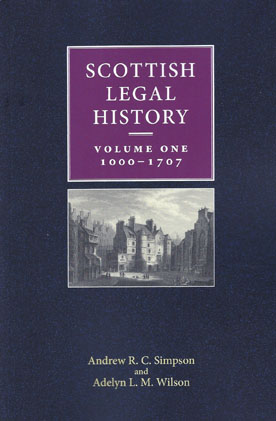Book review: Scottish Legal History Volume 1: 1000 – 1707

Writing a textbook is not an easy endeavour. Not only is it regarded by the broader academic community as belonging to the lower ranks of the hierarchy of publications academics are supposed to aspire to (the single-authored monograph being the ultimate status symbol), but in these REF driven times, there is a general yet unspoken rule that publications of this kind are mostly a waste of time and that authors (primarily younger authors) should be gently, yet firmly guided in other directions. I do not share these opinions and, despite a strong urge to use the remainder of this review lamenting this state of affairs or its negative consequences, I will use this excellent textbook (and it is indeed excellent) to argue the contrary.
Any academic subject can only be taught well if the material from which it is prepared is of sufficient quality. Without wishing to be unfair to any of the current competitors to this textbook, it seems fair to state that Scottish legal history has not always been well served by the available material (either because it was not written with the student in mind or because it was too focused on contested ‘grand narratives’). It is therefore refreshing to find a new textbook that takes the most recent scholarship into account and that does not seem to be too preoccupied with proving or disproving various narratives. For a textbook to be ‘useful’ to students, the writing needs to be clear and concise while at the same time showing sensitivity to contested points and scholarly debates. This book has that in spades. The authors’ use of ‘case studies’ enlivens the narrative wonderfully and the style makes for a very engaging read (miles apart from the ‘and then another thing happened…’ school of historical writing). Also, the use of concise reading lists at the end of each chapter really opens up the subject and gives the student reader insights into the debates.
The book, the first of two volumes planned, covers the period from 1000 – 1707. As any scholar of the past will appreciate, covering seven centuries in the space of nearly 400 pages is not an easy task. To that end, the authors have chosen to structure the narrative into four parts, or themes, in which a number of specific chapters are located. Thus, the four parts contain nineteen chapters in total ranging from chapters specifically devoted to ‘Law and Order in the Highlands and Islands’ to ‘Legal Authority and the Learned Laws’. Each part contains a brief introduction in which the central themes are outlined, and each chapter also includes a conclusion in which the fundamental ideas of the specific chapter are drawn out. It is not my intention to offer a blow-by-blow account of each chapter, so I will focus on a few points that stood out to me. Firstly, I found the authors’ approach to writing the history of Scots law in the context of other events (political, social and economic) particularly compelling. It also makes the narrative quite engaging and lively. Secondly, I was particularly heartened to see (in the final section of the book) the authors’ approach to explaining the importance of legal treatises as authority of law, while at the same time advocating that modern scholars should be aware of editions and ‘movable texts’. The explanation offered for the use of Roman law and its place in the formation of the Scottish common law was particularly convincing, especially in light of more recent scholarship such as that of John W. Cairns and John Ford. Thirdly, I found the thematic approach (e.g. the extension of regal authority, the importance of the Session and the influence of the profession of advocacy) particularly useful.
To summarise: this is an exceedingly good book. Not just in textbook terms, but also as a general history of Scots law. It succeeds admirably in capturing the reader with an engaging narrative and will no doubt be very popular with a broad audience (not only students). The editing has been done to the highest standards and the authors are to be commended for producing a very engaging read. Textbooks are rarely page-turners, but this one indeed is. If volume one is anything to go by, I cannot wait for volume two.
Paul J. du Plessis
University of Edinburgh
Scottish Legal History Volume 1: 1000 – 1707 by Andrew R.C. Simpson and Adelyn L.M. Wilson. Published by Edinburgh University Press, (£40 Paperback) 408pp. This review was first published in Juridical Review Issue 1/2018.




